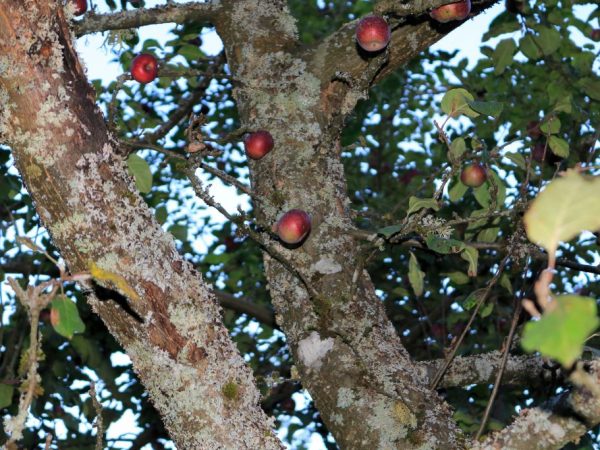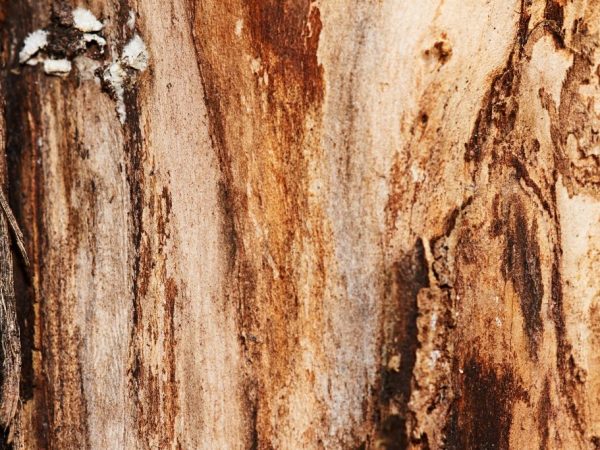Methods of dealing with bark beetle on an apple tree
One of the most common and unpleasant garden pests is the bark beetle on the apple tree, also called the fruit sapwood. This beetle is brown in color, with longitudinal dashed lines on a chitinous shell, covered with hairs, with brown legs and whiskers. It settles in stone fruit trees, which leads to their death.

Methods of dealing with bark beetle on an apple tree
Signs of pest damage
The fruit sapwood lives under the bark of a tree. For this reason, it is difficult to see adults or larvae.
Signs of damage are detected by noticing external changes in plants:
- the appearance of round or oval holes in the bark, up to 2 mm in size;
- the presence of a brown or white substance, similar to flour, at the foot of the tree;
- drying out or wilting of individual branches;
- abrupt stop of fruiting, underdevelopment of the ovary;
- the presence of places of abundant release of gum;
- if woodpeckers often fly to the tree.
Gardeners are also advised to manually verify the health of the apple tree. You need to take a knife and try to pierce the bark. If it easily moved away in a layer, and dark stripes were found under it, the beetle has long settled on a tree.
The good resistance of the upper stratum corneum of the apple tree means that the bark beetle was unable to gnaw it and did not lay eggs for breeding.
Reasons for the appearance
A week after flowering, apple bark beetles fly out to mate and build nests. During this period, males first become active, choose a suitable tree, gnaw a tunnel in it.
Then they lure the females with the secreted pheromones. Fertilized beetles expand the mesh of passages under the bark and lay about 100 eggs at the end of each branch.
Such a process in the thickness of the apple tree is possible only for one reason - the weakened immunity of the plant. Pests can easily gnaw through the top layer of the tree and settle in its thickness. Emaciated and sick apple trees are attacked.
Danger of infection
Fruit sapwoods are attracted by the smell of freshly cut wood. They gather in places where there are uncleaned branches from the garden, stumps. Fresh cuts and wounds on the surface of apple trees and other fruit plants are also at risk.
Infection with bark beetles has the following negative consequences:
- damage to the tree power system;
- violation of the circulation of juices due to the passages gnawed by the larvae;
- the introduction of fungal infections by females into the thickness of apple trees, which soon begin to progress;
- death of the tree.
Control measures

Tree treatment depends on the stage of the disease
To determine how to get rid of pests in the garden, you need to know the extent of the damage. The expediency of treating a tree depends on the color of the "flour" that is pushed out by the sapwood larvae from the holes in the bark.
If it is brown - insects gnaw only the top layer, you can use all known methods of dealing with them.
White "flour" indicates that the beetles have moved to the soft part of the trunk and are distributed around the entire perimeter.It is useless to save such a tree, it will die due to exhaustion and harm. They cut it down, remove the stump with roots, and burn everything away from the site.
Chemicals
Means developed in laboratories have an insecticidal effect. Some of them affect beetles, larvae and pest eggs, the rest destroy only adults. They are used according to the instructions and using full chemical protection - respirator, suit, gloves.
The most famous drugs are:
- "Confidor Extra" - fights against adult beetles and larvae, lasts several weeks after spraying;
- "Bi-58" - affects all generations of insects, penetrating with food to their stomach and killing them;
- "Vitalizer NV-101" - an effective remedy against bark beetles and other pests, fungus, made on the basis of active extracts from coniferous trees;
- Clipper is an experimental drug with a good effect, protects plants for several weeks;
- "Senezh Insa" is a water-based antiseptic for apple and other fruit trees, penetrates into the thickness of the bark, is activated for a long time.
All solutions for fighting bark beetle on an apple tree are used several times. For the first time, the affected and neighboring trees are sprayed a week or two before flowering. The next treatment is repeated in 12-14 days.
Preparations, diluted with water, cover the trunk and all branches, especially in places of damage to the bark and cut off parts of the crown.
Traps and scarers
Traps and repellents are good methods of dealing with adults before the egg is laid. They operate throughout the garden. They are placed depending on the functional orientation.
Traps are created from scrap materials and used as follows:
- freshly cut trees and branches are left around the entire perimeter of the fence;
- bark beetles, having felt their smell, will go to these places;
- after a few weeks, when the females lay eggs, the wood remains are burned away from the site;
- this method allows you to lure and destroy all arriving pests and their future generation.
Some hobbyists buy pheromone traps. But they are not suitable for a garden of less than 5 hectares.
Their action is based on luring all sapwood and other pests in the area to one place. They attack nearby trees and settle in them. This method is justified on large-scale planting areas, where infected plants are subsequently cut down and destroyed with eggs and larvae.
Repellers are sold at specialist gardening stores. These are small tablets containing antiferomone components. They are hung on the branches of all fruit trees before flowering. Apple bark beetles, having noticed the smell of scarers, will leave the territory.
Barrel injection
In situations where apple trees suffer greatly from the invasion of fruit sapwood, the method of introducing insecticides into the trunk is used. This is done using a conventional injection syringe, which is inserted into the hole in the bark made by the beetle.

In case of severe damage, poison is poured under the bark
Such agents diluted in 100 ml of water are capable of destroying insects:
- 0.1 ml of "Confidor Maxi";
- 0.3 ml "Tanreca";
- 0.1 ml "Calypso".
The high concentration will immediately poison the insects in the tunnels. Fighting pests through the procedure is difficult for the tree itself, but such a measure is necessary in case of severe infection. At the end of the injection, the holes are covered with garden pitch.
Traditional methods
The insecticidal mixture is prepared at home. To do this, take 2 glasses of crushed soap and carbolic acid. Dissolve them in 5 liters of water.
The product is diluted 1: 4 with ordinary liquid and sprayed on the bark of the apple tree before flowering and immediately after it. The solution is capable of killing all adults on the surface and getting inside.
Folk remedies also include the treatment of tree trunks in autumn and spring with such substances:
- a mixture of clay and manure;
- by combining slaked lime with humus;
- oil paint, especially in the crevices;
- whitewash for the garden.
Prophylaxis
To prevent infestation of apple trees and other fruit crops with sapwood, you need to carry out all garden care work on time and carefully. These include:
- autumn and spring pruning of dry and damaged branches;
- removal of deadwood, wood, fallen leaves and weeds from the site;
- putty cuts with garden glue or paint;
- looking after plants;
- maintaining the immunity and vitality of trees with phosphorus-potassium fertilizers and watering;
- preventive spraying with insecticidal and antifungal drugs in due time.
It becomes difficult to fight apple bark beetles if the process has begun long ago and the number of pests has increased exponentially. A good prevention can prevent the complete destruction of the garden. It is necessary to remove heavily affected trees from the site without delay.
A rational approach with the use of appropriate means will facilitate the task of supporting the vital functions of apple trees and other fruit crops so that the beetle cannot gnaw the bark of a healthy plant.


